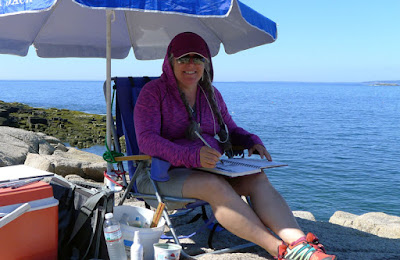The rules work, even when we don’t notice. That’s as true in life and painting as it is in Acadia National Park.
 |
| Photo courtesy of Jennifer Johnson. |
I’ve been getting workshop permits for Acadia National Park since I moved my workshop up to Schoodic Institute. They mean paperwork and expense, and nobody ever asks for them. Sometimes I wonder why I bother.
Yesterday, a ranger stopped by. “Do you want to see my permit?” I asked excitedly. “Oh, please, do you really want to see my permit?”
 |
| Becky comfortable near that sassy ocean. |
He already knew we were going to be there; he was just stopping to check something else. I’m glad that the park rangers know what happens in the park, and that I haven’t been wasting my time and money complying with the permitting system.
Even if we aren’t aware of it, rules continue to be in effect. That’s as true in the universe as it is in a National Park, and it’s a good thing. Nobody wants the earth potting off into a different orbit because it’s sick of the one it has.
 |
| A demo on the rocks near the Mark Island Overlook. |
It is also true of painting. Many paintings of Ralph Blakelock have darkened beyond seeing because he puttered with the chemistry. It’s a terrible pity, because he was a great painter.
The ranger and I chatted for a while about the most inscrutable (to civilians) rule of national parks, that you can’t take natural materials out. “If we have three and a half million visitors and each of them takes home a rock…” he began. In some places, it might save on dredging, but I see his point.
The Mark Island (Winter Harbor) lighthouse was built in 1856, with a keeper’s house added twenty years later. It’s a handsome assemblage of whitewashed walls and staggered rooflines, and it’s far enough away that one can’t really do a stereotypical lighthouse painting. Instead, it must be in the context of its landscape, with Cadillac Mountain rising behind it. The scale relationship is a little misleading, because Mark Island is less than a mile offshore and Cadillac Mountain is several miles away.
 |
| A lighthouse painting doesn’t have to be about the lighthouse. |
Look north or south and there are sweeping diagonals of pink granite tumbling to the sea, framed by dark spruces and crashing surf. And the seas were definitely crashing. “You sassy ocean, you!” cried Becky as a great long foaming breaker blew over the rocks nearby.
| A student studying mixing greens. (Photo courtesy of Donald Fischman) |
A sea fog approached and retreated, finally cloaking us in soft pink cashmere around sunset. That was appropriate, because yesterday’s demo was on the color of light. This subject is like one of those drawings that flips from being a vase to two profiles. It’s easy to see once you get it, but difficult to explain.
| Ravens Nest is fine for an individual painter but not for a class. |
As the afternoon ended, several students walked down to Ravens Nest. I never teach there. There’s no guardrail, only pot warp strung from tree to tree. There’s no room for a large group to paint safely. But it’s an interesting geological formation and quite pretty.
We’ll be heading to Schoodic Point this morning. As I type this, I can hear the surf crashing. The sky is fair and pink. All signs are good for another great day of painting.
